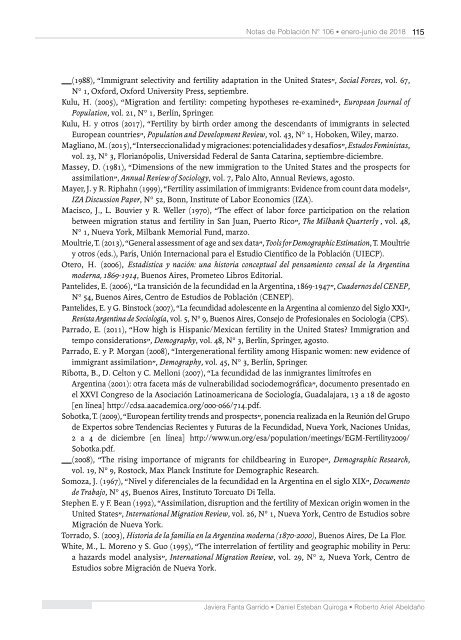Notas de Población N° 106
El número 106 de Notas de Población está conformado por 10 artículos, en cuya elaboración han participado 21 colaboradores. Los artículos abordan diversos temas de investigación relacionados con la mortalidad, el transnacionalismo migratorio y la fecundidad de las migrantes, así como la fecundidad adolescente, el femicidio, la migración de retorno, la segregación en el espacio urbano y el dividendo demográfico.
El número 106 de Notas de Población está conformado por 10 artículos, en cuya elaboración han participado 21 colaboradores. Los artículos abordan diversos temas de investigación relacionados con la mortalidad, el transnacionalismo migratorio y la fecundidad de las migrantes, así como la fecundidad adolescente, el femicidio, la migración de retorno, la segregación en el espacio urbano y el dividendo demográfico.
You also want an ePaper? Increase the reach of your titles
YUMPU automatically turns print PDFs into web optimized ePapers that Google loves.
<strong>Notas</strong> <strong>de</strong> <strong>Población</strong> <strong>N°</strong> <strong>106</strong> • enero-junio <strong>de</strong> 2018<br />
115<br />
(1988), “Immigrant selectivity and fertility adaptation in the United States”, Social Forces, vol. 67,<br />
<strong>N°</strong> 1, Oxford, Oxford University Press, septiembre.<br />
Kulu, H. (2005), “Migration and fertility: competing hypotheses re-examined”, European Journal of<br />
Population, vol. 21, <strong>N°</strong> 1, Berlín, Springer.<br />
Kulu, H. y otros (2017), “Fertility by birth or<strong>de</strong>r among the <strong>de</strong>scendants of immigrants in selected<br />
European countries”, Population and Development Review, vol. 43, <strong>N°</strong> 1, Hoboken, Wiley, marzo.<br />
Magliano, M. (2015), “Interseccionalidad y migraciones: potencialida<strong>de</strong>s y <strong>de</strong>safíos”, Estudos Feministas,<br />
vol. 23, <strong>N°</strong> 3, Florianópolis, Universidad Fe<strong>de</strong>ral <strong>de</strong> Santa Catarina, septiembre-diciembre.<br />
Massey, D. (1981), “Dimensions of the new immigration to the United States and the prospects for<br />
assimilation”, Annual Review of Sociology, vol. 7, Palo Alto, Annual Reviews, agosto.<br />
Mayer, J. y R. Riphahn (1999), “Fertility assimilation of immigrants: Evi<strong>de</strong>nce from count data mo<strong>de</strong>ls”,<br />
IZA Discussion Paper, <strong>N°</strong> 52, Bonn, Institute of Labor Economics (IZA).<br />
Macisco, J., L. Bouvier y R. Weller (1970), “The effect of labor force participation on the relation<br />
between migration status and fertility in San Juan, Puerto Rico”, The Milbank Quarterly , vol. 48,<br />
<strong>N°</strong> 1, Nueva York, Milbank Memorial Fund, marzo.<br />
Moultrie, T. (2013), “General assessment of age and sex data”, Tools for Demographic Estimation, T. Moultrie<br />
y otros (eds.), París, Unión Internacional para el Estudio Científico <strong>de</strong> la <strong>Población</strong> (UIECP).<br />
Otero, H. (2006), Estadística y nación: una historia conceptual <strong>de</strong>l pensamiento censal <strong>de</strong> la Argentina<br />
mo<strong>de</strong>rna, 1869-1914, Buenos Aires, Prometeo Libros Editorial.<br />
Panteli<strong>de</strong>s, E. (2006), “La transición <strong>de</strong> la fecundidad en la Argentina, 1869-1947”, Cua<strong>de</strong>rnos <strong>de</strong>l CENEP,<br />
<strong>N°</strong> 54, Buenos Aires, Centro <strong>de</strong> Estudios <strong>de</strong> <strong>Población</strong> (CENEP).<br />
Panteli<strong>de</strong>s, E. y G. Binstock (2007), “La fecundidad adolescente en la Argentina al comienzo <strong>de</strong>l Siglo XXI”,<br />
Revista Argentina <strong>de</strong> Sociología, vol. 5, <strong>N°</strong> 9, Buenos Aires, Consejo <strong>de</strong> Profesionales en Sociología (CPS).<br />
Parrado, E. (2011), “How high is Hispanic/Mexican fertility in the United States? Immigration and<br />
tempo consi<strong>de</strong>rations”, Demography, vol. 48, <strong>N°</strong> 3, Berlín, Springer, agosto.<br />
Parrado, E. y P. Morgan (2008), “Intergenerational fertility among Hispanic women: new evi<strong>de</strong>nce of<br />
immigrant assimilation”, Demography, vol. 45, <strong>N°</strong> 3, Berlín, Springer.<br />
Ribotta, B., D. Celton y C. Melloni (2007), “La fecundidad <strong>de</strong> las inmigrantes limítrofes en<br />
Argentina (2001): otra faceta más <strong>de</strong> vulnerabilidad socio<strong>de</strong>mográfica”, documento presentado en<br />
el XXVI Congreso <strong>de</strong> la Asociación Latinoamericana <strong>de</strong> Sociología, Guadalajara, 13 a 18 <strong>de</strong> agosto<br />
[en línea] http://cdsa.aaca<strong>de</strong>mica.org/000-066/714.pdf.<br />
Sobotka, T. (2009), “European fertility trends and prospects”, ponencia realizada en la Reunión <strong>de</strong>l Grupo<br />
<strong>de</strong> Expertos sobre Ten<strong>de</strong>ncias Recientes y Futuras <strong>de</strong> la Fecundidad, Nueva York, Naciones Unidas,<br />
2 a 4 <strong>de</strong> diciembre [en línea] http://www.un.org/esa/population/meetings/EGM-Fertility2009/<br />
Sobotka.pdf.<br />
(2008), “The rising importance of migrants for childbearing in Europe”, Demographic Research,<br />
vol. 19, <strong>N°</strong> 9, Rostock, Max Planck Institute for Demographic Research.<br />
Somoza, J. (1967), “Nivel y diferenciales <strong>de</strong> la fecundidad en la Argentina en el siglo XIX”, Documento<br />
<strong>de</strong> Trabajo, <strong>N°</strong> 45, Buenos Aires, Instituto Torcuato Di Tella.<br />
Stephen E. y F. Bean (1992), “Assimilation, disruption and the fertility of Mexican origin women in the<br />
United States”, International Migration Review, vol. 26, <strong>N°</strong> 1, Nueva York, Centro <strong>de</strong> Estudios sobre<br />
Migración <strong>de</strong> Nueva York.<br />
Torrado, S. (2003), Historia <strong>de</strong> la familia en la Argentina mo<strong>de</strong>rna (1870-2000), Buenos Aires, De La Flor.<br />
White, M., L. Moreno y S. Guo (1995), “The interrelation of fertility and geographic mobility in Peru:<br />
a hazards mo<strong>de</strong>l analysis”, International Migration Review, vol. 29, <strong>N°</strong> 2, Nueva York, Centro <strong>de</strong><br />
Estudios sobre Migración <strong>de</strong> Nueva York.<br />
Javiera Fanta Garrido • Daniel Esteban Quiroga • Roberto Ariel Abeldaño


















